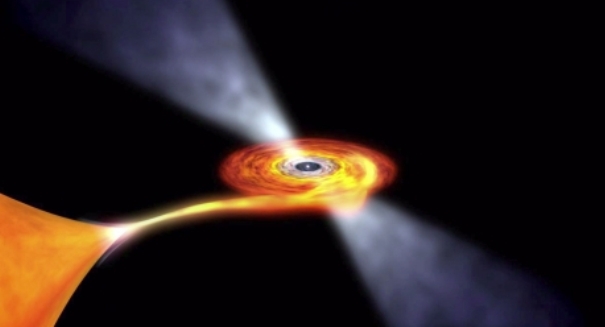
A pulsar is a magnetized neutron star that gives off pulses of light.
Astronomers have found a “transformer” pulsar. According to a news release from NASA’s Goddard Space Flight Center, the star transforms back and forth between two mutually exclusive styles of pulsed emission — X-rays and radio.
“This transitional object took us decades to find, and it provides us with a unique opportunity to observe a pulsar’s intense magnetic field in action,” said co-author Sergio Campana, an astronomer at Brera Observatory, in a statement.
According to astronomers, the rise and fall of gas streaming onto the pulsar from a companion star throws the switch to X-rays and back to radio.
NASA notes that a pulsar is a magnetized neutron star that gives off pulses of light. A neutron star is extremely dense, making it the closest thing to a black hole that astronomers can study directly.
The fastest known millisecond pulsar rotates at 43,000 revolutions per minute. Astronomers believe that they rotate so quickly because pulsars live in binary systems with normal stars.
Over time, the gas stream also slowly accelerates the pulsar’s rotation.
After approximately a billion years, the gas streaming from the normal companion star decreases and ultimately stops, ending the X-ray pulses generated by the build-up of gas. However, given its increased spin and intense magnetic field, which together generate radio emission, the neutron star could continue working as a radio pulsar.
NASA’s Swift telescope spotted a flash of X-rays from IGR J18245-2452 on March 29. This allowed astronomers to pinpoint the source at the core of the globular star cluster M28.
“Swift provided the first accurate, subarcminute localization of the X-ray burst, which allowed for the additional discovery of the pulsar’s radio waves by the Australia Telescope Compact Array (ATCA),” said Jamie Kennea, a Swift team member at Penn State.
A week later, the ESA’s XMM-Newton satellite detected X-ray pulses from the object. By studying variations in the arrival time of these pulses, the astronomers determined that the pulsar was accompanied by a small companion star.
On April 5, the team observed variable radio emission with ATCA, but then, several days later, IGR J18245-2452 emitted a burst of X-rays.

“Swift’s Burst Alert Telescope was dynamically triggered by X-ray bursts from this star, which allowed its XRT to rapidly confirm the thermonuclear character of this explosion,” said John Nousek, professor of astronomy and astrophysics at Penn State.
Alessandro Papitto of the Institute of Space Sciences in Barcelona and his colleagues compared the pulsar’s spin and orbital features to characteristics for known radio pulsars in M28 and discovered a match with PSR J1824-2452I.
Later in April, NASA’s Chandra observatory helped nail down the location of the X-ray source, but radio observations conducted around the same time were unable to detect radio emission. However, astronomers using a variety of telescopes were able to intermittently identify the pulsar’s radio emissions.
Shortly thereafter, the same pulsar revealed clear proof of accretion-powered X-ray emissions, as demonstrated by thermonuclear explosions, and rotation-powered signals at radio wavelengths.
What exactly was going on?
The astronomers believe that the answer can be found in the interaction between the pulsar’s magnetic field and changes in the gas flow from the normal companion star. During times when the mass flow is less extreme, the magnetic field stops the gas from arriving at the surface and generating X-ray emission. With the area around the neutron star mostly gas free, radio signals can make their getaway.
“At high mass flow rates, the gas squeezes the magnetic field and is able to reach the surface to produce X-ray emission. At the same time, the dense cloud of ionized gas surrounding the pulsar quenches the radio signals, effectively blocking them from our view,” Papitto said.
Previously, astronomers thought that these pulsars “transformed” from X-rays to radio over millions of years.
The study’s findings are described in greater detail in the journal Nature.
What do you think of the discovery? Let us know in the comments section.
is a